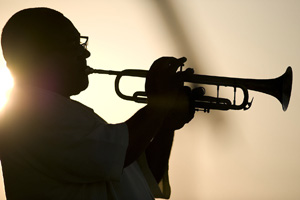Chicago In the News
The Chronicle’s biweekly column Chicago In the News offers a digest of commentary and quotations by a few of the University faculty members, students and alumni who have been headlining the news in recent weeks. Chicago faculty members are some of the most frequently quoted experts, so space allows publishing references to only selected examples. To read many of the full newspaper articles mentioned in this column, visit the University News Office Web site: http://news.uchicago.edu.
‘Pushing technologies to limit’
Bob Stanek of Argonne National Laboratory’s High Energy Physics Division was featured on Sunday, Sept. 28 in a 60 Minutes story about the Large Hadron Collider at the European Organization for Nuclear Research (known as CERN). Stanek has worked for the past 14 years on the collider, which went online recently, only to be shut down for repairs. The goal of the $8 billion machine, the world’s largest particle accelerator, is to recreate the conditions fractions of a second following the creation of the universe. “It’s in humans’ interest to know everything. And why wouldn’t you want to know that?” Stanek asked. “We, in doing these experiments, do push the technologies to the limit.” Monica Dunford, a postdoctoral scholar and fellow at the Enrico Fermi Institute, also was interviewed.
Dinosaur, bird link strengthened
The discovery of a 33-foot-long dinosaur that breathed 85 million years ago, much like modern birds, was reported in the Monday, Sept. 30 Chicago Tribune. University paleontologist Paul Sereno, Professor in Organismal Biology & Anatomy, led a joint American-Argentinian expedition that discovered the fossils of Aerosteon riocoloradensis, a meat-eater the size of an elephant that breathed with a unique bellows-like system. “In breathing, bird lungs don’t expand and contract,” Sereno said. “Instead, birds have a system of bellows—air sacs—that shunt air through the bird’s ‘rigid lungs.” The discovery provides clues as to whether birds originally evolved from dinosaurs. The discovery was also reported in National Geographic, Live Science, the Daily Telegraph, McClatchy News Service and USA Today.
Export of water causes waves
Anu Bradford, Assistant Professor in the Law School, weighed in on the debate over the export of bottled water from the Great Lakes in a Sunday, Sept. 29 article in the Washington Post. A decade-long campaign to block the wholesale export of Great Lakes water ended successfully recently, although many want to close a “bottled-water loophole.” The question is whether bottling water from aquifers that feed the lakes should be seen as human consumption, commercial production or the expert of a natural resource. “How do we decide when water is a product? Under the WTO and NAFTA, there is no obligation for a state to extract its natural resources,” Bradford said. “The difference comes when it makes the decision to allow an entity to commercialized it and they do commercialize it. Then it is a product, and you can’t ban the export.”
Study: Dog fighters getting younger
A recent study from the University of Chicago Survey Lab found that dog fighting is becoming more prevalent among urban youths. According to the Monday, Sept. 29 USA Today, the most active and numerous dog fighters are inner-city youths, ages 13 or 14 or 17, who train pit bulls to fight dogs in the neighborhood. One advocate estimates that at least 100,000 youngsters are fighting dogs under the radar in America. The Survey Lab found that urban dog fighting is seen as a way to gain credibility and earn money at a young age. “This kind of stuff doesn’t have anything to do at all with the dog,” said Kelly Daley, Co-Director of the Chicago Survey Lab, who led the study.
Poison a powerful cancer antidote?
The University Medical Center made a 40-year-old Indiana man the first patient in the world to receive a promising new drug made from scorpion venom. The substance, TM601, is aimed at treating brain cancer and is a synthetic form of a molecule made from the venom of the giant yellow Israeli scorpion. The venom targets glioma cells and delivers iodine-131 radiation to kill cancer cells. Steve Chmura, Assistant Professor in Radiology and Cellular Oncology, said early results show that TM601 “shockingly homes right in on glioma cells. It’s amazing to look at images of the patient’s brain and see the drug targeting just the cancer cells.” The Medical Center is initially treating 10 patients with the drug and also has launched the first study of TM601 administered intravenously for patients with recurring cancer. The research was reported in the Sunday, Sept. 28 Chicago Tribune.
Scholars: Iran finally standing up
 Photo by Chris Strong | |
Music festivals hit right note
The Chicago Tribune reported on a pair of music festivals at the University and surrounding community in articles on Monday, Oct. 6 and Friday, Sept. 26. The first gave a positive review of the University of Chicago Presents’ Messiaen Music Festival, which began Thursday, Oct. 2 and runs through Saturday, Oct. 11. The author wrote of the festival: “No one who cares about the music of our time can afford to stay away.” The other story chronicled the growth of the Hyde Park Jazz Festival, which celebrated its second year on Saturday, Sept. 27 at Rockefeller Memorial Chapel and International House, as well as two other Hyde Park venues.
![[Chronicle]](/images/sidebar_header_oct06.gif)